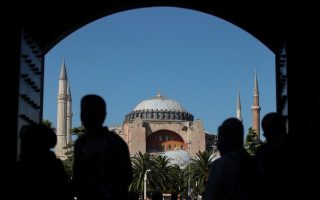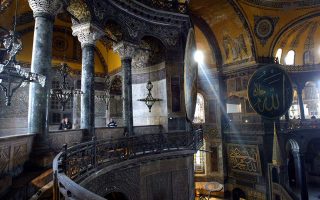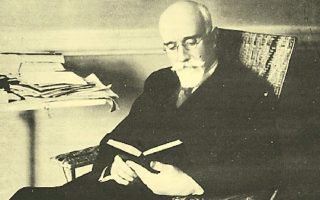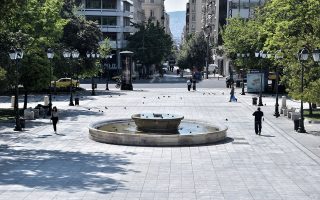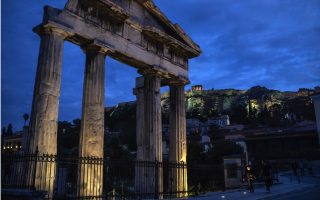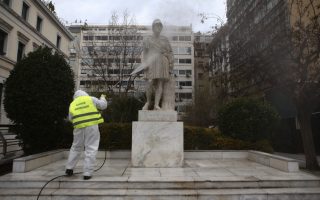Haghia Sophia being rendered ‘closed and silent’
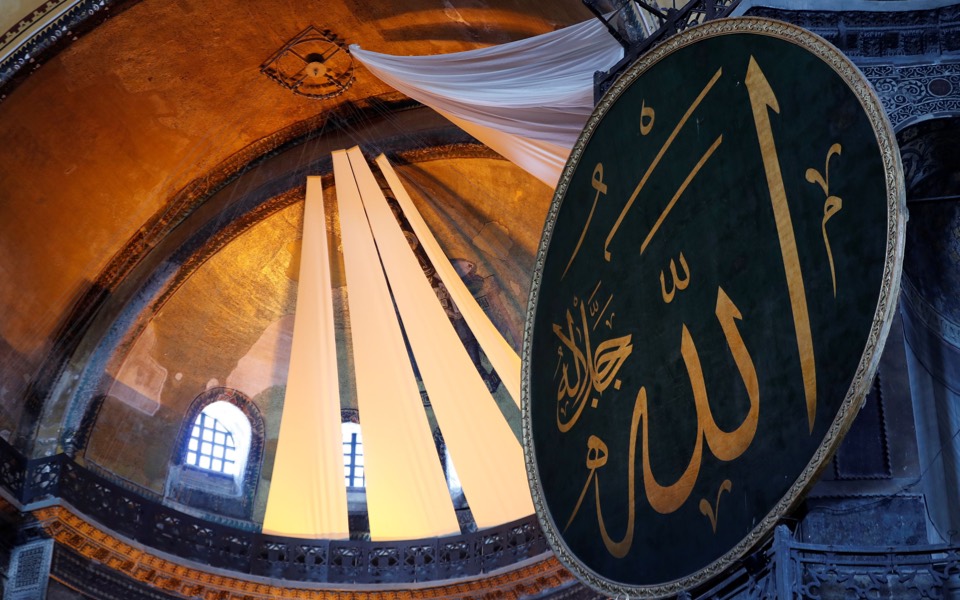
The Republic of Turkey’s recent decision to convert the Hagia Sophia museum back into a mosque marks a serious moment in contemporary history, and we should all be aware of this.
When Hagia Sophia, a church dedicated to Divine Wisdom, was consecrated by Emperor Justinian in AD 537, it stood as the largest religious building in Christendom and as the most imposing architectural tribute ever paid to God by human ingenuity. The basilica soon became the center of the Empire’s religious and political life: as the patriarchal see, Hagia Sophia housed all the solemnest ceremonies of Byzantine public life.
In the 9th century, after the end of the Iconoclastic Controversy, its interior walls were adorned with figurative mosaic panels skillfully executed by refined craftsmen from Constantinople for the purpose of celebrating the sacred images as well as imperial sovereignty. In Hagia Sophia, whose dome stands as though suspended from the heavens, emperors were crowned; in Hagia Sophia, the splendor of the Orthodox liturgy led to the conversion of the Russian people; in Hagia Sophia, on the morning of May 29, 1453, the terrified people gathered for one last, desperate prayer; in Hagia Sophia Mehmed II made his triumphal entrance to take control of the whole city, which had its heart in the basilica. The Conqueror was amazed by the magnificence of the building – so much so that, according to our sources, he struck a soldier who, blinded with fanaticism, was shattering the marble floor.
The year 1453 marked the beginning of a new course in Hagia Sophia’s history: like almost all churches in Constantinople, it was turned into a mosque. Its bold structure continued to exercise an irresistible pull on all later architects: from the great Sinan, who designed Suleiman’s mosque, to his pupil Sedefkar Mehmed Agha, who is responsible for erecting the splendid Blue Mosque. The basilica had been the cultural center of the Byzantine Empire and it preserved its prestigious role throughout the Ottoman period. Sultans always showed a keen interest in this building, which had endured across the centuries and which in the mid-19th century revealed a series of mosaics – brought to light by the Swiss Fossati brothers during restoration work commissioned by Sultan Abdulmejid.
In 1934 Kemal Ataturk, who was aware of the symbolic role that Hagia Sophia could play in his modernized and forward-looking Turkey, decided to establish the building as a heritage site for the whole of mankind by turning it into a museum. This laid the foundations for the restoration of its rich iconographic apparatus, through the preservation of all the (Christian and Islamic) elements it had acquired over the course of its history.
In 1985 UNESCO designated four historic areas of the city of Istanbul a World Heritage Site. With its Outstanding Universal Value, it stands as “a unique testimony to interactions between Europe and Asia over the centuries.” UNESCO has acknowledged Hagia Sophia as a unique architectural masterpiece, as “the model for a number of churches, and later, mosques.” In order to establish a suitable management of UNESCO sites, starting with the 2002 Budapest Declaration, which was also signed by Turkey, specific guidelines have been provided for an equitable balance between conservation, sustainability and development, as well as to better preserve our world heritage.
The Budapest Declaration thus called for a management plan to ensure the effective protection of this heritage and the transmission of all its aspects and values to future generations. The plan for Hagia Sophia’s management within the Sultanahmet Archaeological Park, drafted in 2010, did not entail any change in its status, in keeping with the preservation of the balance between the various monuments included in the Park.
Hagia Sophia has been, and continues to be, the focus of numerous studies on Byzantine civilization, because it is ‘living proof’ of the remarkable architectural renewal and of the most refined forms of artistic expressions produced from the 6th century onward, and which have reached us through the centuries – for the most part whole and unchanged. The countless and highly relevant scholarly contributions devoted to the monument testify to the wide range of interests it has inspired and continues to inspire.
This research focuses not just on the most visible aspects of the building – its architecture and decorative and iconographic apparatus, as rich as it is unique – but also on the recovery of less evident traces: the numerous marks left by stone-masons who worked on the enormous building site; the graffiti left on its marble by pilgrims, travelers and ambassadors over the course of centuries; and the chronological layers and the variety of architectural solutions that have led to the preservation of a vast, composite, and protean structure.
Yet Hagia Sophia is also a place where it is possible to investigate its lesser-known aspects, such as the complex plays of light so eloquently described by ancient sources or sound and its propagation in an architectural space surmounted by a vast dome and four half-domes – a space where the symbolic interpretation of liturgical and ornamental apparatuses brings out the building’s deep underlying meanings. The material and immaterial aspects of the building – knowledge of which has important repercussions in the fields of religious, sociological, theological, philosophical, liturgical and economic studies – are part of what we would describe today as a ‘suprahistorical’ and ‘supranational’ culture that reveals the role of man and of societies, which we have come to know by investigating the past. Regrettably, some precedents already indicate what the consequences are of reconverting a museum and former Christian religious building into a mosque.
In 2013, following a decision made by local authorities, ownership of the Church of Hagia Sophia at Trabzon was transferred to the Religious Affairs Directorate, opening the building up to Muslim worship. A slow yet systematic operation to conceal its Byzantine past began: from the covering up of the marble floor to the concealment of frescoes behind textiles; from the visual obliteration of the apse of the church to the removal of all the statuary collected in the areas at the back of the monument. Trabzon is a ‘prototypical’ expression of the kind of legal transformation also undergone by the Hagia Sophia in the town of Vize in Turkish Thrace, as well as by the well-known Hagia Sophia in the town of Iznik in Bythinia, and – in 2020 – by the Hagia Sophia in Enez, on the Greek border, a site of archaeological excavations.
Italy is among the countries most concerned with the changes under way at Hagia Sophia, owing to its close links with the Byzantine East. The history of Byzantium is closely intertwined with that of Italy; so much so that, outside of Constantinople, some of the most conspicuous examples of Byzantine art are to be found on Italian territory – as in the case of the famous mosaic portraits of Justinian and Theodora at Ravenna, which are coeval with Hagia Sophia. Justinian brought Italy within the borders of the Empire, and for centuries southern Italy continued to gravitate within the Byzantine orbit, cherishing – alongside artistic testimonies – traces of the Greek language, which continues to be spoken by communities in Calabria and Salento.
Therefore, Italian culture has always displayed a great interest in Byzantium, as is shown by the extensive teaching of Byzantine history, civilization, art history and archaeology at many Italian universities, as well as by the publication of numerous high-level academic journals specifically devoted to the Greek Middle Ages.
Italian Byzantinists enjoy good international standing and through their research they have established their country as one of the leading promoters of Byzantine studies. Alongside the academic community, the Italian Association of Byzantine Studies (Associazione Italiana di Studi Bizantini) has been set up, which boasts over 170 members and which, along with other, similar national associations, is part of the broader International Association of Byzantine Studies (AIEB).
It was only to be expected that these strong and rooted cultural interests would translate into bewilderment and indignation on the part of our scholarly community, which is dismayed at Turkish President Recep Tayyip Erdogan’s decision – supported by his Council of State – to strip Hagia Sophia of its status as a museum, a status consolidated over many decades, also through the contributions made by Italian researchers to the archaeological, historical and artistic investigation of the monument. By removing Hagia Sophia from the neutral field of its fruition as an architectural and artistic monument, and by restoring it as a site of Muslim worship, the interior of the building – as well as its exterior, where findings from Hagia Sophia at the time of Theodosius II are located – will undergo a radical alteration, through the covering up of all its decorative apparatus and of its outstanding marble floor. This will seriously compromise visitors’ aesthetic perception of the building complex.
Hagia Sophia is not merely a monument, but a rich and inexhaustible source of historical knowledge, a document open to investigation that – through its reversion back into a place of worship, with all the inevitable alterations this entails – is destined to become closed and silent. Little more than a century has passed since it was first turned into a museum, and it has yet to recount all the historical events in which it has played a leading role. Like an antique book, it ought to be preserved with the utmost care in all of its integrity: an integrity that its status as a museum has certainly contributed to ensuring, not least through the joint interventions and efforts between local authorities and many Italian and international universities and institutions, engaged in research projects and delicate restoration campaigns. Through enlightened cultural policies and the exchange of scholarly expertise and know-how, it has been possible to rally our forces around a ‘shared cause’: preserving a valuable heritage.
One is bound to feel anguish at the egregious display of intolerance and ideological narrowness that President Erdogan is making before the international community. What makes this decision all the more bitter is the ostentatious desire of the highest Turkish authority to use this gesture of ‘reconquest’ as a means to exalt the violence that stands at the roots of the building’s modern history. Hagia Sophia had become a symbol of humanity’s effort to overcome history rather than being its victim.
Not just as scholars, but also – and especially – as members of humanity, we ask you to take a stand and to do everything possible to prevent the perpetration of what appears to be an act of abuse against all peoples of the world and against their hopes for reconciliation and peace.
For more information on the Italian Association of Byzantine Studies, visit its official website at www.studibizantini.it.
